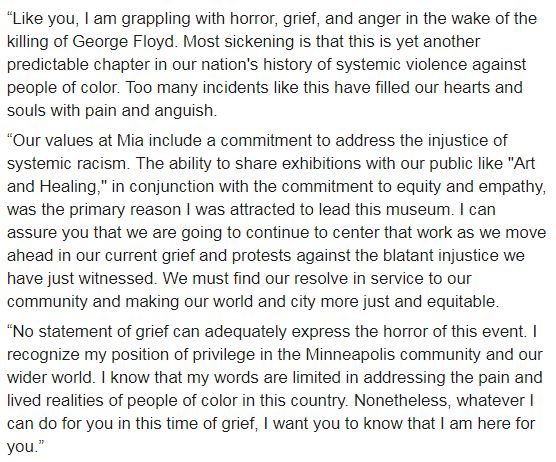
In a striking departure from their customary reluctance to take strong political stands that would alienate some visitors, art museums around the country, speaking separately but with one voice, responded to the asphyxiation of George Floyd.
The Metropolitan Museum arguably had the most startling response, in the form of today’s stark banner at the top of its homepage:

Here’s an excerpt from President Daniel Weiss‘s and Director Max Hollein‘s above-cited Letter from the Met’s Leadership, addressed to the museum’s staff, but made public on its website:
The recent murder of George Floyd at the hands of a police officer, and the ensuing nationwide protests, are yet another indictment of how deeply injustice flows in the United States and how urgent is the need for change….
The Met stands in solidarity with the Black community, and we join you in calling for justice. There is much work that The Met needs to do, and we are committed to doing it….
The frustration, disbelief, and anger in this country is palpable everywhere, and perhaps especially here in New York. Many of you have raised your voices on the streets and on social media, rightly demanding justice. We must come together as a Met community to grieve and to reflect on how we, as individuals, and as a museum, can do more to support social justice efforts in this country….
We are planning for a series of virtual conversations with all staff in the weeks ahead, when we can speak directly with you about current events, the Museum’s response to the ongoing pandemic, re-opening plans, and more.
I did a doubletake on Monday as my mild-mannered art-centric Twitter feed erupted in a flurry of fury. Using similar language, museum after museum vented anger and anguish over a white policeman’s sadistic asphyxiation of a black man, horrifyingly captured on multiple video cameras (compiled in this NY Times narrated video).
Below is what I then tweeted about what I then saw as a “watershed moment for museums.” (You can click the link next to each museum’s name to see its tweet. The first image (now replaced with a larger one that has the same wording), linked from the Boston Museum of Fine Arts’ homepage to its Director’s Message.)
It’s as if they coordinated, but might be independent outrage at wrongs: @MetMuseum‘s strong Message of Solidarity with the Black Community: https://t.co/BwbuJxgd9T; @HighMuseumofArt https://t.co/j7rxhshU8M; @WalkerArtCenter https://t.co/ScCf7N8Gwa Conspicuously silent: @ArtsMia
— Lee Rosenbaum (@CultureGrrl) June 2, 2020
Give it a chance: Actions may follow words. This feels like a watershed moment for museums.
— Lee Rosenbaum (@CultureGrrl) June 2, 2020
Yesterday (the day after the above tweets were posted), the Minneapolis Institute of Arts (@ArtsMIA), which I had described as the “conspicuously silent,” was no longer Missing in Action. Its delay was notable because the George Floyd asphyxiation, not to mention the Philando Castile shooting by a police officer (famously livestreamed by his fiancée on Facebook) had occurred in the Twin Cities area.
On a day when many art museums posted black squares on their Instagrams and Twitter feeds as part of #BlackOutTuesday (meant to show solidarity for the protesters), the Minneapolis Institute finally went public on Twitter with a statement that its five-month director, Katie Luber, had sent last week to staff, volunteers & supporters:

Introducing that tweeted statement (which is not linked on MIA’s homepage at this writing) is this attempt at reassurance:
This is only a small step toward future commitment & action. We condemn the murder of George Floyd, reject systemic racism & acknowledge that we have a lot of work to do. We’re listening and learning.
Artists around the world have been quick to respond, creating public murals and other paintings memorializing the “Black Lives Matter” martyr.
We don’t know yet if all these sympathetic responses will result in systemic change combating systemic racism. One thing I do know, as a journalist who has covered art museums for almost five decades, is that the traditionally apolitical posture of insular nonprofit cultural institutions has been exploded in the flash of a hashtag.
This is not Philippe de Montebello‘s Met—nor mine, for that matter: I grew up in in the Bronx in the ’50s and early ’60s, cherishing museums (especially the Met) as places for escape into the tranquil contemplation of beauty. I’m still more comfortable with museums’ making implied (rather than explicit) political statements, through the art that they show and the inclusiveness of their staffing and programming.
We now interrupt this dreamy nostalgia for today’s breaking news from the Minneapolis StarTribune:
Attorney General Keith Ellison’s office on Wednesday upgraded charges against the former Minneapolis police officer who knelt on George Floyd’s neck and charged the other three officers at the scene with aiding and abetting murder….
Former officer Derek Chauvin, who [was] recorded on video kneeling on Floyd’s neck as he begged for air on May 25, now faces the more serious charge of second-degree murder, in addition to the original charges of third-degree murder and second-degree manslaughter with culpable negligence….
First-degree murder requires proof of planning out the crime.
The time has come to stop characterizing such incidents as “excessive use of force”—the term used in a Wall Street Journal op-ed piece today to describe the Floyd killing.
Say its name—Police Brutality. It has to stop.
